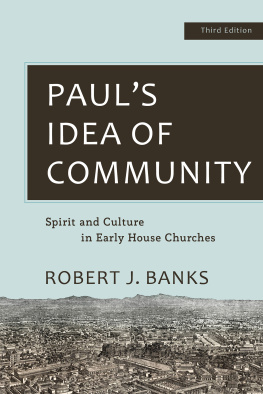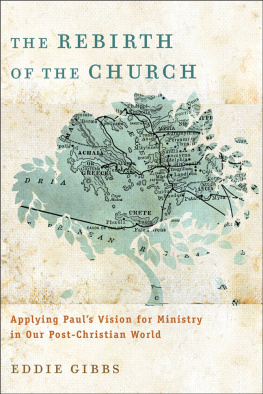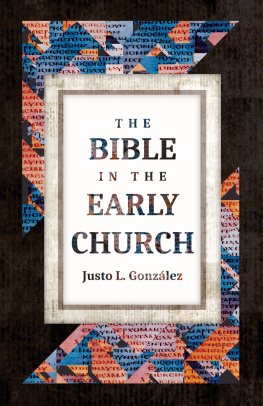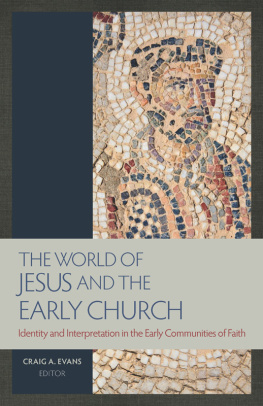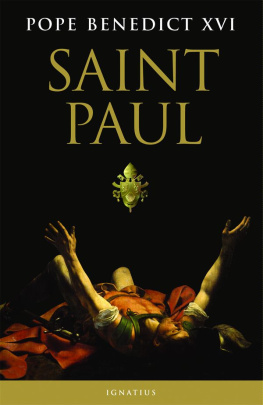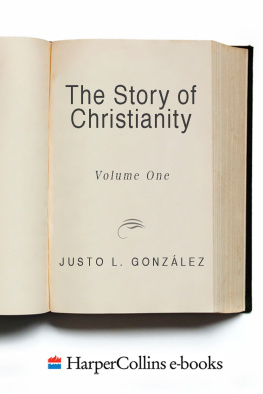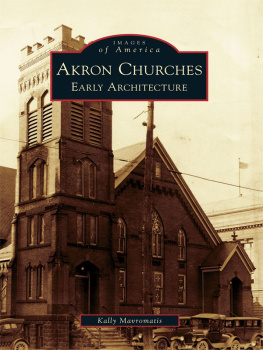Robert J. Banks - Pauls Idea of Community: Spirit and Culture in Early House Churches
Here you can read online Robert J. Banks - Pauls Idea of Community: Spirit and Culture in Early House Churches full text of the book (entire story) in english for free. Download pdf and epub, get meaning, cover and reviews about this ebook. year: 2020, publisher: Baker Publishing Group, genre: Religion. Description of the work, (preface) as well as reviews are available. Best literature library LitArk.com created for fans of good reading and offers a wide selection of genres:
Romance novel
Science fiction
Adventure
Detective
Science
History
Home and family
Prose
Art
Politics
Computer
Non-fiction
Religion
Business
Children
Humor
Choose a favorite category and find really read worthwhile books. Enjoy immersion in the world of imagination, feel the emotions of the characters or learn something new for yourself, make an fascinating discovery.
- Book:Pauls Idea of Community: Spirit and Culture in Early House Churches
- Author:
- Publisher:Baker Publishing Group
- Genre:
- Year:2020
- Rating:4 / 5
- Favourites:Add to favourites
- Your mark:
- 80
- 1
- 2
- 3
- 4
- 5
Pauls Idea of Community: Spirit and Culture in Early House Churches: summary, description and annotation
We offer to read an annotation, description, summary or preface (depends on what the author of the book "Pauls Idea of Community: Spirit and Culture in Early House Churches" wrote himself). If you haven't found the necessary information about the book — write in the comments, we will try to find it.
Robert J. Banks: author's other books
Who wrote Pauls Idea of Community: Spirit and Culture in Early House Churches? Find out the surname, the name of the author of the book and a list of all author's works by series.
Pauls Idea of Community: Spirit and Culture in Early House Churches — read online for free the complete book (whole text) full work
Below is the text of the book, divided by pages. System saving the place of the last page read, allows you to conveniently read the book "Pauls Idea of Community: Spirit and Culture in Early House Churches" online for free, without having to search again every time where you left off. Put a bookmark, and you can go to the page where you finished reading at any time.
Font size:
Interval:
Bookmark:
1994, 2020 by Robert J. Banks
Published by Baker Academic
a division of Baker Publishing Group
PO Box 6287, Grand Rapids, MI 49516-6287
www.bakeracademic.com
Originally published in 1979 by Anzea Publishers, Australia.
Ebook edition created 2020
All rights reserved. No part of this publication may be reproduced, stored in a retrieval system, or transmitted in any form or by any meansfor example, electronic, photocopy, recordingwithout the prior written permission of the publisher. The only exception is brief quotations in printed reviews.
Library of Congress Cataloging-in-Publication Data is on file at the Library of Congress, Washington, DC.
ISBN 978-1-4934-2158-9
Unless otherwise indicated, Scripture quotations are from the Revised Standard Version of the Bible, copyright 1946, 1952 [2nd edition, 1971] National Council of the Churches of Christ in the United States of America. Used by permission. All rights reserved worldwide.
Scripture quotations labeled NIV are from the Holy Bible, New International Version. NIV. Copyright 1973, 1978, 1984, 2011 by Biblica, Inc. Used by permission of Zondervan. All rights reserved worldwide. www.zondervan.com. The NIV and New International Version are trademarks registered in the United States Patent and Trademark Office by Biblica, Inc.
Scripture quotations labeled NLT are from the Holy Bible , New Living Translation, copyright 1996, 2004, 2007, 2013, 2015 by Tyndale House Foundation. Used by permission of Tyndale House Publishers, Inc., Carol Stream, Illinois 60188. All rights reserved.
Scripture quotations labeled NRSV are from the New Revised Standard Version of the Bible, copyright 1989 National Council of the Churches of Christ in the United States of America. Used by permission. All rights reserved.
Cover
Half Title Page
Title Page
Copyright Page
Preface to the Third Edition
Preface to the Second Edition
Preface to the First Edition
Abbreviations
Introduction
1. The Sociocultural and Religious Settings
2. The Gospel of Other-Directed Freedom
3. Church in Family Business Residences
4. Church as Present Heavenly Reality
5. The Community as a Loving Household
6. The Community as an Organic Harmony
7. Mutual Learning and Testing of Faith
8. Common Meals and Signs of Fellowship
9. The Sharing of Gifts and Ministry
10. The Interplay of Grace and Order
11. Unity and Diversity among the Members
12. The Contribution of Women in Church
13. Abolishing Religious Distinctions between Members
14. Defining Leadership by Function, Not Position
16. The Link between Mission and Church
17. The Nature of Pauls Authority
18. The Exercise of Pauls Influence
Conclusion
Appendix 1: The Drift of the Pastorals
Appendix 2: Going to Church in the First Century
Glossary
Select Bibliography
General Index
Scripture and Ancient Sources Index
Back Cover
I had never envisaged this modest book having such a long and useful life. It is particularly pleasing that it continues to cross the boundary between academic and general audiences, finding its way into scholarly writings, theological courses, and practitioners hands, as well as being appreciated by a wide range of thoughtful lay people.
This third edition is a thoroughly revised and updated version of the original edition that appeared forty years ago. It continues to provide a comprehensive account of what Paul said that is accessible to both an academic and an otherwise thoughtful audience, and not only to those who are religiously inclined but also to those more historically interested in first-century Christianity. This has affected the form of the book. It seeks not only to interpret Paul but also to set him firmly in his context. Only by placing him within his social and cultural setting, and comparing him with his contemporaries, do the genuinely distinctive elements in his approach appear. For while in many respects Paul was very much a man of his times, in other ways he was astonishingly ahead of them.
Though this is not a technical work, it is based on a thorough investigation of the relevant primary and secondary sources and offers a number of fresh interpretations of his writings. For me, interest in Pauls view has been stimulated not only by academic study but also by involvement in groups convinced that Paul has a vital relevance to their life. We learn about the past not just by rational reflection upon it but by personal involvement in present activities that have links with it.
In formatting the footnotes and bibliography I have borne in mind those who will mainly use them. References to secondary works have been excluded to avoid unnecessarily weighing down the presentation. Instead I have provided an extensive select bibliography geared around the main themes of the book, omitting only works in foreign languages because of the wider audience the book has in view. References to less accessible sources (e.g., collections of Greek papyri or inscriptions and some rabbinic commentaries or codes) are to those editions that are more readily available. A glossary describes the main figures, works, and movements cited in the book for those who are less familiar with them.
Since the second edition of the book appeared in the early nineties, the main developments in Pauline studies have been first in social and cultural studies of Pauls writings and period and second in works on Pauls missionary and ecclesial endeavors. Though these social and cultural studies continue to provide varying interpretations of the actual form of Pauls communities, they have definitely helped portray his activities. Even though they have not always produced agreement between scholars, they have helped portray what he did in more concrete and everyday terms. Meanwhile, substantial exegetical and theological treatments of Pauls writings have continued to extend and enrich our interpretation of Pauls thought and life. Interaction with all these recent studies of Paul has continued to inform and nuance my understanding of his ideas and practice.
I am particularly delighted that the publishers agreed to include in this volume my booklet Going to Church in the First Century . This little exercise in what is now called narrative exegesis was first written as a companion piece to Pauls Idea of Community shortly after publication. It has also gone through several editions but until now has only ever been published separately. I have found that this storied version of the material in the larger book works with a wide range of audiencesfrom Sunday School classes, youth fellowships, adult Bible studies, reading groups, and seminary classes, to theological facultyand has also been translated into several other languages, including Korean, Japanese, Danish, and German.
Robert Banks
Canberra
September 2018
Although it is fifteen years since this book appeared, there seems to be a continuing demand for it. This has provided the opportunity for me to work through the text again and make various improvements. I have wanted to do this for some time.
This second edition is the result of a thoroughgoing revision. Only a few paragraphs remain completely untouched. One consequence of this is that the text reads more easily and clearly. I have also refined some of its interpretations and viewpoints so as to take into account more recent scholarly investigations of Pauls writings and my own ongoing reflections. The bibliography has been extended and fully updated, and an index of ancient sources has been added. Indispensable in all this has been the help of Shirley A. Decker-Lucke, Assistant Academic Editor at Hendrickson Publishers. She has been everything one could hope for in an editor, and I am deeply grateful to her.
Font size:
Interval:
Bookmark:
Similar books «Pauls Idea of Community: Spirit and Culture in Early House Churches»
Look at similar books to Pauls Idea of Community: Spirit and Culture in Early House Churches. We have selected literature similar in name and meaning in the hope of providing readers with more options to find new, interesting, not yet read works.
Discussion, reviews of the book Pauls Idea of Community: Spirit and Culture in Early House Churches and just readers' own opinions. Leave your comments, write what you think about the work, its meaning or the main characters. Specify what exactly you liked and what you didn't like, and why you think so.

